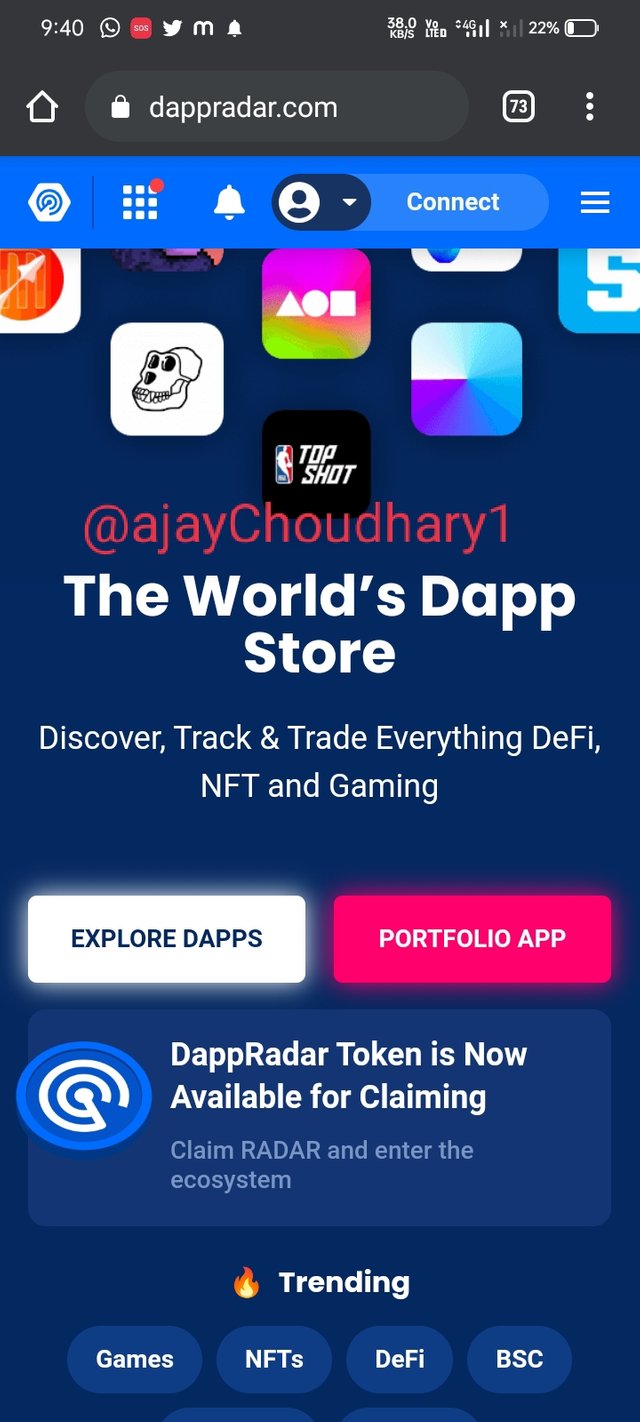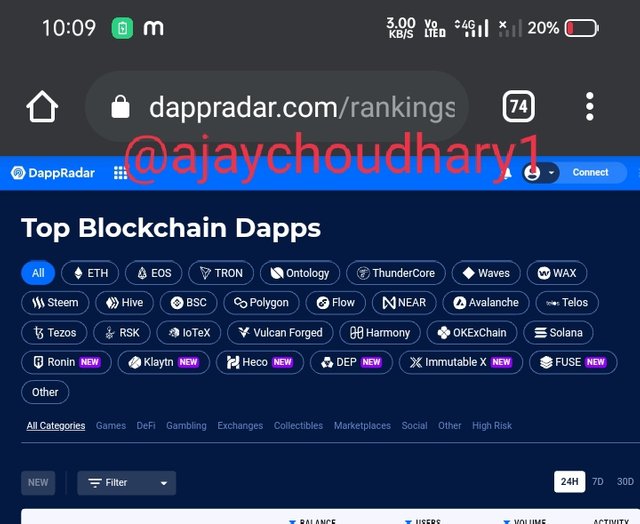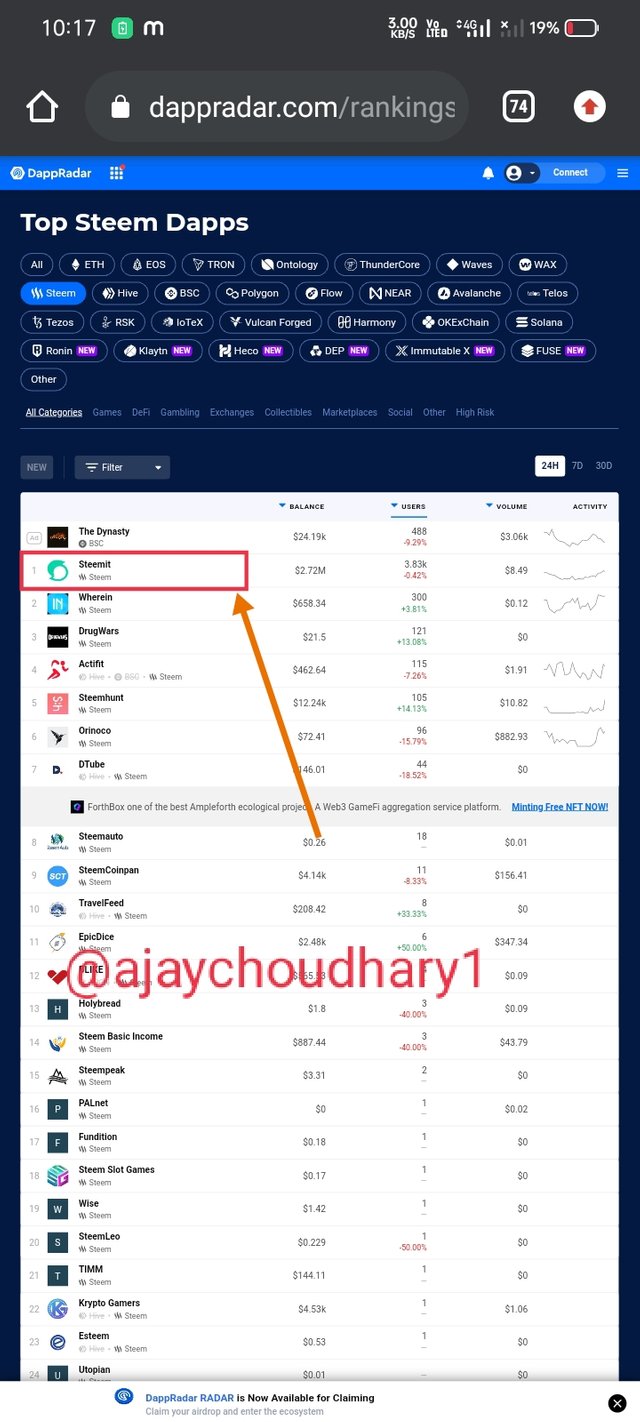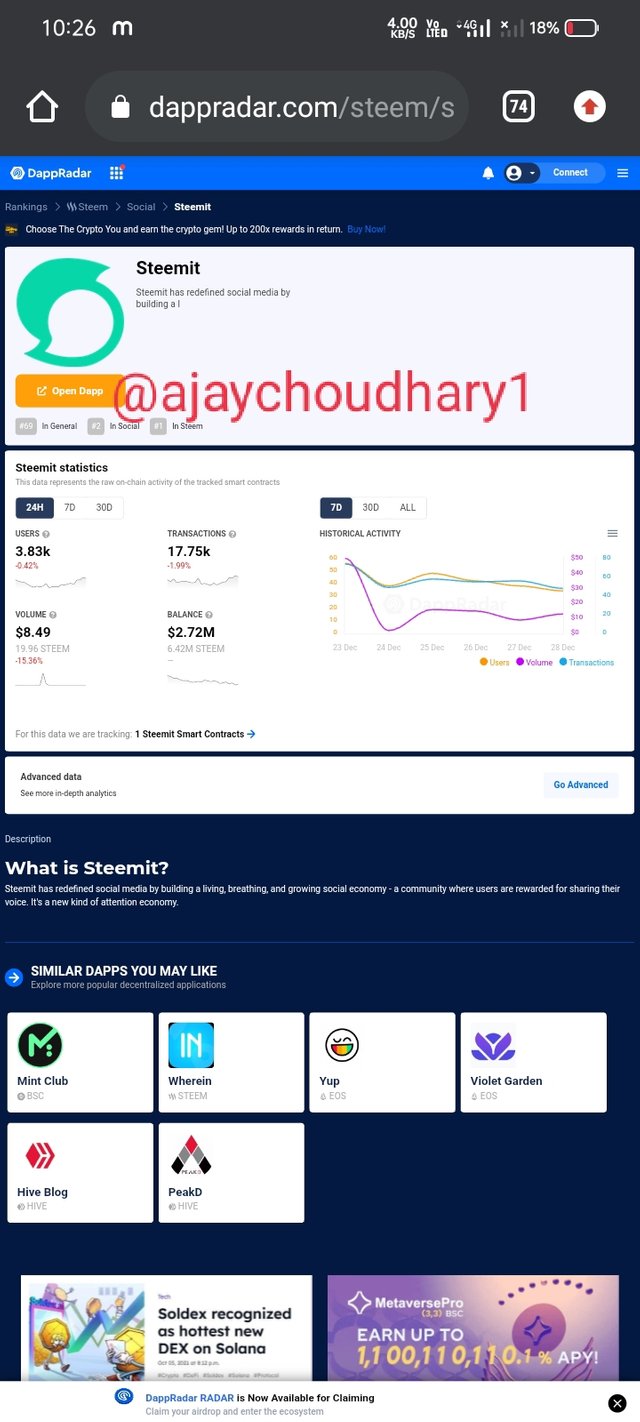[dapps] - Crypto Academy S5 - Homework Post for Task 8
What are dApps?
Explain the working system of dApps?
What are the differences between dApps and other applications?
Explain the advantages and disadvantages of dApps?
How can dApps developers promote their apps?
What should we pay attention to when using dApps?
How do we find the information of a DApp that we want to know? Provide the steps (Screenshot required).
What are dApps?
Dapps are blockchain-based decentralised applications that are controlled by a decentralised network rather than using control points or a central authority.
It's a network in which the same people are in charge of all aspects of the system's operation. It is both secure and transparent because it allows users to log in and register using any service or device while retaining security through its cryptographic encryption technology.
As a result, the node will no longer exist in the network, but it will continue to exist in the network.
DApps are decentralised applications that are gaining acceptance in the cryptographic environment on a daily basis as a way for consumers to keep control of their money.
This is due to the blockchain network's design, which allows users to communicate and establish agreements without the need for a third party to maintain our data.
DApps are a type of cutting-edge application that uses a blockchain organisation and stores all of the customers' information on a simple organisation that can be accessed using a high-security encryption technology. Decentralized applications are more gotten than unified applications with this level of security.
Assuming you work for someone in an united company, this model indicates you don't own anything.
They will have all of your information in their possession, allowing them to use you until their needs are met, after which they will release you.
Furthermore, decentralised application exchanges are more practical than concentrated application exchanges since decentralised apps use a distributed trading technique that is quite small and does not include any outsider.
You have complete control over your resources, and no one else is involved in the transactions. There is no one or primary governing architecture in decentralised applications. There is an opportunity for everyone to have control of their records in their own unique way.
A blockchain network is a distributed system. Unlike the centralization application, which requires an entity central, these Dapps types rely on a smart contract that allows developers to protect and encrypt the network while also generating tokens for each user depending on their algorithm cryptographic procedure (PoW and PoS).
Explain the working system of dApps?
A smart contract is a process that takes place in the middle of two blockchains. Smart Contracts are fixed mostly because they may gather and record data clarification in decentralised networks and applications in order to provide data and information to users.
All DApp transactions are recorded by these Smart Contracts, which may be viewable to anyone. These Smart Contracts in DAaps make speed faster with less fees because no third party is involved.
Smart Contracts are built on code agreement and cannot be removed because DApps use them for their operations and transactions. As we all know, DAaps operates on a peer-to-peer network, allowing users to execute functions between each other without consuming a lot of power, resulting in high transaction costs.
Dapps employ the Ethereum blockchain for data storage and smart contracts for app logic, and they run on a decentralised blockchain network.
The data in a Dapp that has been launched on the Etherium blockchain cannot be changed because the Dapp's code has been developed and placed in the smart contract.
Nodes in the blockchain network carry out the functionality and operations of dApps. These nodes are users' computers that are connected to a decentralised blockchain network, with each user representing a node.
This, however, only applies when a transaction has been completed. It is approved by qualified or selected nodes. As previously stated, validators are users who meet the requirements of the given consensus system of the blockchain on which this dapp runs. Once the transaction is validated, it is completed instantly.
The smart contract system is similar to a trustless and permissionless method that makes the working doctrine of dApps straightforward or simple, fast, secure, and decentralised.
What are the differences between dApps and other applications?
There has been considerable debate over the difference between dApps and applications since the introduction of dApps, however there isn't much of a difference between dApps running on a public blockchain platform and other apps running on any operating system or the web when you look at it closely.
Decentralization vs. centralization
The fundamentals distinctions Between them stems is mostly from the underlying notions of decentralisations.
DECENTRALIZED application's, unlikely typically apps that's are regulates by a centralised controlling authority's, run on a peer to peer Blockchain.
Trustable
DECENTRALIZED Application's have a high level of user confidence since consumer's retaining control and ownerships of theirs data and assets. Regularly apps, on the others hand, are more user-friendly in terms of ease of use.
Development Costs
When creating a standard app, numerous variables must be considered, such as the cost of cloud server fees, maintenance expenses, and so on. However, when's it comes to dApps, Blockchain Developer's do not Have to worrying abouts such things as dApp costs, Which included developments, deployments, and even upgrading.
Speed
The pace of dApps is relativelys poor when's compares to regularly application's. Such apps, according to Blockchain Developer's, can only executed about 15 transactions per second.
Security
Blockchain-based app's are more secured than traditionally mobile app's in term of Security. Theses programmed are tamper-proof and the records they're keep are unalterable since they're are DECENTRALIZED. It's worth noting that's When someone's used a dApp, their wallet address and interactions are saved, and this information is visible to everyone. They are, however, safe.
Usage Cost
As we all know, most ordinary apps are free, which means that users do not have to pay anything to use them. Users of dApps, on the other hand, must pay a tiny charge each time they use a decentralised programme. If you're wondering how much these apps cost, keep in mind that the more intricate they are, the more they cost.
Explain the advantages and disadvantages of dApps?
The Benefits and Drawbacks of dApps
Advantages
Many of the benefits of dApps are related to the program's ability to protect user privacy. Users of decentralised apps do not have to provide personal information in order to access the app's features. Smarts contract are used in DApps to conducted transaction Between two anonymously individual's without relying on a Central authority's.
dApps can be developed as alternative social media platforms, according to proponents of free expression. Because no single participant on the blockchain can delete or block messages from being posted, a decentralised social media platform would be impervious to censorship.
Ethereum is a versatile framework for developing new dApps, allowing developers to focus their efforts on finding new and novel uses for digital applications. This could allow dApps to be deployed quickly in a range of areas, such as banking and finance, gaming, social media, and online retail.
Disadvantages
Because the use of dApps is still in its early phases, it is experimental and subject to a variety of issues and unknowns. There are concerns about the applications' ability to scale properly, particularly if an app requires a lot of computations and overloads a network, producing network congestion.
Another's challenges is the capacity to create a user is friendly interfaces. Most users of traditional centralised institution-developed apps have an expectations of ease-of-use that motivates them to utilise and interact with the app. To persuaded people to switch to dApps, developers will need to delivery an end-user experience and degree of performance that rivals that of well-known and established programmes.
Another drawbacks of dApps is the difficulty of making code changes. A dApps will very certainly required continually revisions After it has Been deployed to the improved it or to fixed bug or Security threats. Developer's may find it difficulty to Makes necessary upgrades to dApps, accordingly to Ethereum, because the Data and code broadcast to the Blockchain are difficulty to changes.
How can dApps developers promote their apps?
The development of decentralised apps (DApps) does not rely on a centralised service provider such as Google or Apple. Blockchain technology is used to create apps.
As a result, the application has the advantages of openness and transparency without entrusting control to third-party servers. As a result, decentralised apps are better at addressing some of the issues that centralised apps have.
This post will teach you how to create decentralised applications. By the end, you'll understand how DApps can be more beneficial than standard apps.
Cryptocurrencies are the most well-known applications that have been developed using this technology.
Every day, new sorts of applications are being developed.
Web apps created on top of the blockchain are known as decentralised applications. This usually suggests it's decentralised and open source.
Instead of a centralised server, DApps run on a peer-to-peer network.
What should we pay attention to when using dApps?
To begin with, DApps function in the same way that traditional desktop or mobile apps do. They can also be used to create a website. The only difference is that it is not hosted on any local or cloud servers, unlike the other apps and web pages.
DApps operate on a public blockchain, which is simply a collection of nodes. Although you may be aware that blockchain is a public distributed ledger, it is also known as a network of nodes that maintain an identical ledger.
To create a DApp, you must first understand how a blockchain works.
A blockchain typically maintains an open ledger that records data, and nodes across the network manage similar or identical copies of the ledger.
How do we find the information of a DApp that we want to know? Provide the steps (Screenshot required).
There are a variety of ways to obtain the information on the Dapps that you require, but I'll provide you with a link to a site that I use myself. DappRadar is the name of the app. It's a fantastic service that provides comprehensive information about any currency, trades, and Dapps.
Various blockchains are listed below. However, for outlines, I'm using the Steem blockchain.
After that, you can select your preferred Dapp from the hive blockchain. As a result, I've decided to go with steemit Blog. After that, you can select your preferred Dapp from the hive blockchain. As a result, I've decided to start a steemit blog.
This tab contains all of the information. I'm viewing info about steemit blog since I'm identified with the application you choose.
Conclusion
This was an awesome lecture by professor. It contains many precious information about dapps. Thanks to professor for providing this helpful lecture.




Hello professor @dilchamo.
My task is not graded yet☹️
@dilchamo.
Please check this task.
@dilchamo.
Please check this task.